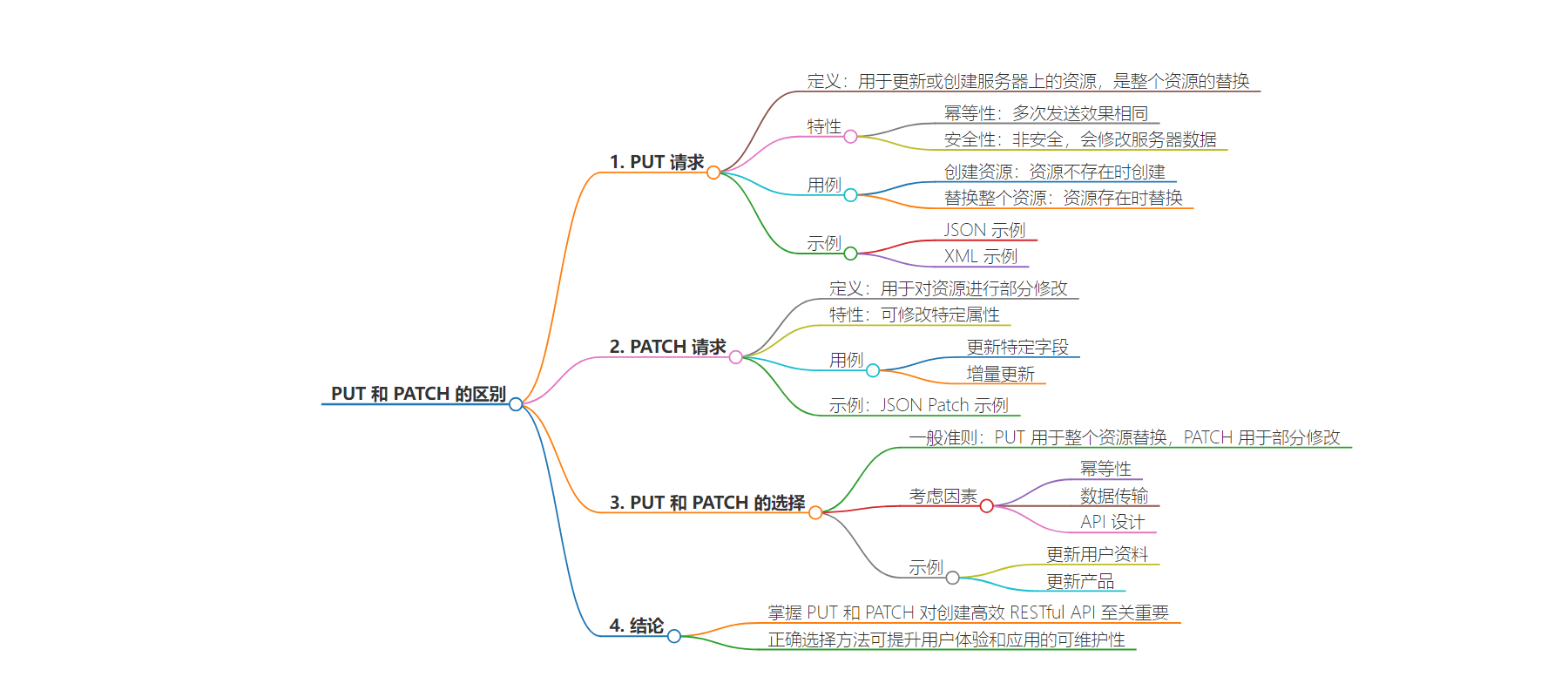包阅导读总结
1.
关键词:RESTful APIs、PUT、PATCH、Update、Difference
2.
总结:本文探讨了在构建 RESTful APIs 中 PUT 和 PATCH 两种用于更新资源的 HTTP 方法的区别。包括定义、特性、用例、示例及如何选择,旨在帮助开发者合理运用,优化 API 设计和用户体验。
3.
主要内容:
– PUT 请求
– 定义:用于更新或创建资源,替换整个资源。
– 特性:具有幂等性但不安全。
– 用例:创建新资源、替换已有资源。
– 示例:包括 JSON 和 XML 格式的示例。
– PATCH 请求
– 定义:用于对资源进行部分修改。
– 特性:只修改特定属性。
– 用例:更新特定字段、增量更新。
– 示例:JSON Patch 格式示例。
– 选择 PUT 还是 PATCH
– 一般准则:完全替换用 PUT,部分修改用 PATCH。
– 考虑因素:包括幂等性、数据传输、API 设计等。
– 示例:如更新用户信息和产品信息的不同情况。
– 结论
– 掌握 PUT 和 PATCH 的细微差别对构建高效的 RESTful APIs 很重要。
思维导图:
文章地址:https://www.javacodegeeks.com/2024/08/put-or-patch-understanding-the-difference.html
文章来源:javacodegeeks.com
作者:Eleftheria Drosopoulou
发布时间:2024/8/2 11:56
语言:英文
总字数:835字
预计阅读时间:4分钟
评分:87分
标签:RESTful API,HTTP 方法,PUT,PATCH,API 开发
以下为原文内容
本内容来源于用户推荐转载,旨在分享知识与观点,如有侵权请联系删除 联系邮箱 media@ilingban.com
When building RESTful APIs, updating existing resources is a common operation. Two HTTP methods often come into play for this purpose: PUT and PATCH. While both are used to modify data, they serve distinct functions.
This article will delve into the key differences between PUT and PATCH requests, providing clear examples and guidelines to help you choose the appropriate method for your API.
1. Understanding PUT Requests
Definition of PUT
A PUT request is used to update or create a resource on a server. Think of it as replacing an entire item with a new version. The request includes the entire representation of the resource, and the server should replace the existing resource with the one provided in the request.
Idempotency and Safety of PUT
- Idempotent: A PUT request is idempotent, meaning you can send it multiple times, and it will have the same effect as sending it once. For example, if you update a user’s profile with the same information twice, the result will be the same as updating it once.
- Safe: A PUT request is not considered safe. It modifies data on the server, so it can potentially have side effects.
Use Cases for PUT
- Creating a resource: If a resource doesn’t exist, a PUT request can create it.
- Replacing an entire resource: If a resource already exists, a PUT request replaces it with the new representation sent in the request body.
Examples of PUT Requests
JSON Example
Imagine you have a user resource with the following structure:
{ "id": 1, "name": "John Doe", "email": "johndoe@example.com"}
To update the entire user resource, you would send a PUT request with the updated user data in the request body:
PUT /users/1 HTTP/1.1Content-Type: application/json{ "id": 1, "name": "Jane Doe", "email": "janedoe@example.com"}
XML Example
For XML, the structure would be similar:
PUT /users/1 HTTP/1.1Content-Type: application/xml<user> <id>1</id> <name>Jane Doe</name> <email>janedoe@example.com</email></user>
The specific format (JSON or XML) depends on the content type specified in the Content-Type header.
2. Understanding PATCH Requests
Definition of PATCH
Unlike PUT, a PATCH request is used to apply partial modifications to a resource. Instead of replacing the entire resource, it specifies changes to specific attributes.
Partial Updates with PATCH
With PATCH, you can modify only the fields you want to change. This is useful when you want to update a small part of a resource without affecting the entire data.
Use Cases for PATCH
- Updating specific fields: Modify only certain attributes of a resource, leaving others unchanged.
- Incremental updates: Apply changes gradually, without replacing the entire resource.
Examples of PATCH Requests
There are different formats for PATCH requests, but we’ll focus on JSON Patch, which is defined by RFC 6902.
JSON Patch Example:
Imagine you want to change the user’s name to “Jane Smith” and increase their age by 1. You would send a PATCH request with the following JSON Patch document:
PATCH /users/1 HTTP/1.1Content-Type: application/json[ {"op": "replace", "path": "/name", "value": "Jane Smith"}, {"op": "add", "path": "/age", "value": 1}]
This example demonstrates how to use JSON Patch operations to modify specific parts of the resource.
Other formats like XML Patch also exist, but JSON Patch is more commonly used.
3. When to Use PUT vs PATCH
Choosing between PUT and PATCH depends on the desired outcome of the request.
General Guidelines
- Use PUT when you want to replace the entire resource with a new version.
- Use PATCH when you want to modify specific parts of a resource without replacing the entire thing.
Considerations
- Idempotency: If the operation needs to be idempotent (producing the same result regardless of the number of times it’s executed), PUT is generally preferred.
- Data Transfer: If you’re sending a large amount of data, PATCH might be more efficient as it only sends the changed parts.
- API Design: Consider the overall design of your API and how these methods align with your resource modeling.
Examples
- Updating a user profile:
- If you want to replace all user information, use PUT.
- If you only want to change the user’s email address, use PATCH.
- Updating a product:
- If you want to replace the entire product with a new version, use PUT.
- If you want to change the product price or description, use PATCH.
Below we will present the cases scenarios in tabular format for better reference
| Scenario | Use PUT | Use PATCH |
|---|---|---|
| Update entire user profile | Yes | No |
| Change user email address | No | Yes |
| Update entire product | Yes | No |
| Change product price or description | No | Yes |
4. Conclusion
Mastering the nuances of PUT and PATCH is a cornerstone of crafting intuitive and efficient RESTful APIs. By understanding their distinct purposes and applying them judiciously, you can significantly enhance the user experience and maintainability of your applications.
While the choice between PUT and PATCH might seem straightforward, the subtleties involved can make a substantial impact on your API’s behavior. It’s my hope that this guide has equipped you with the knowledge to confidently select the appropriate method for your specific use cases.
